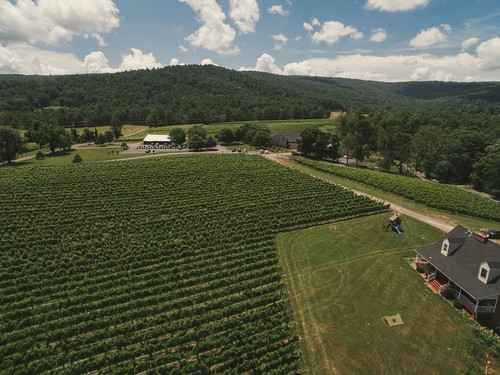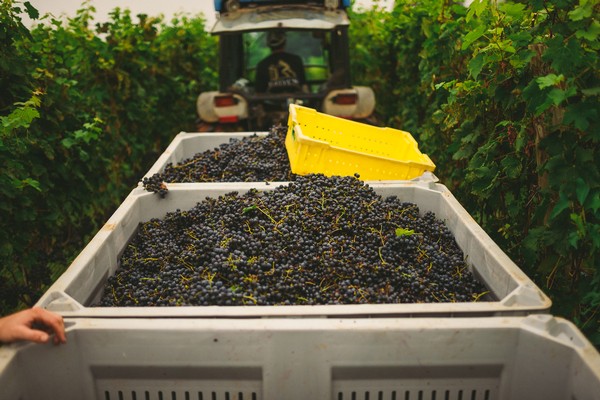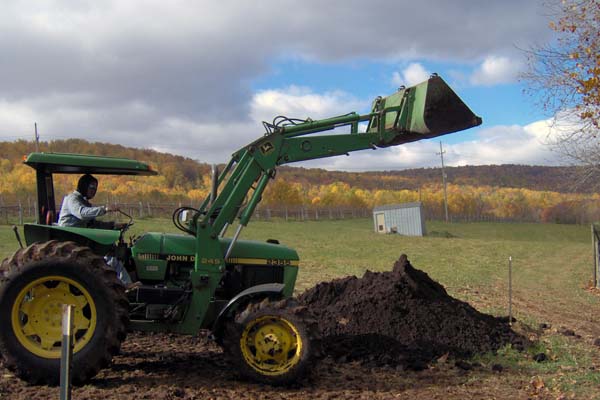Our Vineyards
When you live by the firm belief that “wine is made in the vineyard,” you come to realize that selecting the right vineyard site, and carefully tending the vines, are the most important things we do here at Rappahannock Cellars. Thus our estate vineyard is our “goose that lays the golden egg,” so to speak.
 Our estate vineyard at Rappahannock Cellars is commonly known as the “Glenway Vineyard,” as it’s located on the historic Glenway Farm in Rappahannock County (circa 1804.) We strive to grow the highest quality grapes in Virginia, while at the same time being environmentally sensitive to the land, and leaving the smallest possible footprint on our farm. We are keenly aware that not only do we derive our livelihood from this land, but we also live and raise our children on it.
Our estate vineyard at Rappahannock Cellars is commonly known as the “Glenway Vineyard,” as it’s located on the historic Glenway Farm in Rappahannock County (circa 1804.) We strive to grow the highest quality grapes in Virginia, while at the same time being environmentally sensitive to the land, and leaving the smallest possible footprint on our farm. We are keenly aware that not only do we derive our livelihood from this land, but we also live and raise our children on it.
Let’s start from the beginning: why the Glenway Farm? We selected this farm for a multitude of reasons, including:
- It’s location along the Northern Blue Ridge and its associated micro-climates, which has proven to be some of the best environments for growing European wine grapes east of the Rocky Mountains.
- The sandy-loam soil composition, which allows for beneficial water drainage and deep root growth.
- The property’s absolute elevation (above 900’) and its relative elevation; both contribute to minimizing frost and winter cold damage to the vines.
- The gentle sloping land encourages air flow, while still allowing for safe workability of the farm.
Our farm was purchased in 1998 and first planted with grape vines in 1999. We originally planted eight varietals: Chardonnay, Cabernet Sauvignon, Cabernet Franc, Petit Verdot, Viognier, Seyval, Norton, and Vidal. We have since introduced Merlot, Malbec, and Chardonnel to our site; we also planted additional Petit Verdot, Cabernet Franc, and Viognier vines. Our vineyards are now comprised of eleven varietals, and total over twenty planted acres.
As time marches on, we have enjoyed the ability to appreciate not only which varietals grow best in Virginia, but also which varietals grow best here at the Glenway Farm; most importantly, we’ve learned which varietals grow best in each unique micro-climate on our farm. Now armed with some of this information, we’ve embarked on a program to fine-tune our vineyard: last year, we extended our Viognier block; this year, we’re removing our Vidal and Chardonnel vines to replace them with Norton, and we’re removing the lower half of our Cabernet Sauvignon block in favor of Petit Verdot; next year we’ll add additional Cabernet Franc, Petit Verdot, and Merlot vines, thereby raising our total grape acreage to approximately 25 acres. It’s an exciting process to be able to fine-tune and grow our vineyard, and to see the results of “years of work.”
The vineyard is nurtured by our vineyard manager Tom Kelly (Virginia Grape Grower of the year, and former VVA president) . We are constantly monitoring vine health, fruit condition, and soil health, while trying to tread very lightly on the farm. We strive for sustainable and environmentally sound practices in the vineyard: we’ve experimented with a number of pest and weed controls, which have allowed us to be nearly pesticide and herbicide free, and we continue to work with various controls to employ the safest methods possible. We also compost our winery waste (grape seeds, skins, and stems) and use them to replenish the soils on our farm.
The results of selecting such a great site, paying extremely close attention to the vineyard, and “babying” each vine, has lead to a consistent pattern of incredible fruit quality each and every year. Growing wine is science; growing great wine is an art …so cheers to the Artist!

Photo Courtesy of C&I Photographer, Stan Murzyn
We have incorporated several “sustainable practices” in the vineyard. Many of these practices have been in use for a long time in the industry, and most of what is listed below has been in practice since the inception of the vineyard in 1999.
1.) Under vine row cover cropping: We have all but eliminated the use of herbicides underneath the vines and are using a specialized mower for control of grasses and weeds. This provides the following benefits:
- Chemical herbicides can acidify the soil which creates an environment that is toxic to the micro organisms that live there. These organisms are critical to the decomposition of organic matter and in making nutrients available to plant roots.
- The plants that exist under the vine row send roots down through the soil, which help hold the soil in place and create “channels” by which water can percolate through improving drainage. This not only reduces the potential for erosion, but also keeps the vines from getting “wet feet”. These plants also compete with the vine for water and nutrients which, in turn helps us control/reduce vine vigor.
- When we mow down the plants, they decompose and return valuable nutrients and organic matter to the soil. Currently, we have only allowed the native weeds and grasses to return to the areas under the vines. I am hoping to begin to establish controlled crops in the vine row which can be customized to the site and to different varieties to improve the performance of all of the above. We are also experimenting with a new machine that utilizes flame technology to super heat weeds, thereby disrupting their cell structure, causing them to die.
2.) Composting: I have implemented an ‘on farm composting program’ that utilizes winery waste (pumice) and spent horse bedding imported from local farms. These are mixed in a 50/50 ratio in long pile called a “windrow” and turned every so often until completely composted. This compost is nutrient rich with high amounts of organic matter. Currently, I can create about 40 tons of compost annually which is enough to cover roughly one third of the vineyard. Composting in the vineyard allows us to dramatically reduce the amount of chemical fertilizers we need to use to feed the vines as well as improve soil structure and health. The other big benefit to my program is that there is little to no cost to us (besides labor) to generate this compost and we are able to return to the vineyard what we remove. Other farms in Virginia use compost in the vineyard but most of them have to purchase it from a compost manufacturer at a significant cost (much more than chemical fertilizer). Few make their own.
3.) Integrated Pest Management (IPM): Unfortunately, mildew and rot pressure in Virginia vineyards (as a result of our climate) will not allow us to avoid the use of fungicide sprays or grow organic grapes at this time. However, we try to use as many natural compounds (such as sulfur, copper, hydrogen dioxide, and phosphorus acid) and biological fungicides and insecticide products as possible. These products too have their limitations in how much we can use (before they have a damaging effect on the environment) and their relative effectiveness, so we cannot rely on them exclusively. Our best approach is to rotate these products with other chemicals and use the most advanced equipment to deliver them to their target so we can achieve the most effective sprays at critical intervals. This should allow us to use less chemical less often. My spray program changes constantly based on weather and disease pressure and I have a large ‘tool box’ of products at my disposal so I don’t have to over use any product to damaging levels.

Creating our compost allows us to further our green initiatives and lessen our impact on the environment.
4. 5 years ago we became the first Virginia Winery to be completely solar replaced!
Also, we are currently researching several other programs to reduce our environmental foot print. These include but are not limited to; establishing habitat for beneficial insects that are predators to harmful pests such as leaf hoppers and Grape Berry Moth, and converting to bio-diesel fuel to run our tractors.
